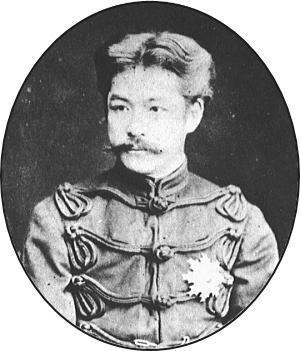Name Prince Yoshihisa Rank Lieutenant General | Years of service 1887-1895 Parents Prince Fushimi Kuniie | |
 | ||
Battles/wars Taiwan Expedition of 1874 Children Prince Tsunehisa Takeda, Prince Naruhisa Kitashirakawa Grandchildren Prince Tsuneyoshi Takeda, Prince Nagahisa Kitashirakawa Grandparents Fushimi-no-miya Sadayuki-shinno Similar People Prince Naruhisa Kitashirakawa, Prince Nagahisa Kitashirakawa, Prince Kuni Asahiko, Emperor Jimmu | ||
Prince Kitashirakawa Yoshihisa (北白川宮能久親王, Kitashirakawa-no-miya Yoshihisa-shinnō, 1 April 1847 – 5 November 1895) of Japan, was the second head of a collateral branch of the Japanese imperial family. He was formerly enshrined in Tainan-Jinja, Taiwan, under the name Kitashirakawa no Miya Yoshihisa-shinnō no Mikoto as the main and only deity.
Contents
Early life
Prince Kitashirakawa Yoshihisa was the ninth son of Prince Fushimi Kuniye (1802–1875). He entered the Buddhist priesthood under the title Rinnoji-no-miya. He served as abbot of Kan'ei-ji in Edo.
Bakumatsu period
During the unrest of the Boshin War to overthrow the Tokugawa Shogunate, Prince Yoshihisa fled north with Tokugawa partisans of the following the Satsuma-Chōshū takeover of the city of Edo, and was made the nominal head of the "Northern Alliance" (Ōuetsu Reppan Dōmei). This short-lived alliance consisted of almost all of the domains of northern Japan under the leadership of Date Yoshikuni of Sendai. Documents exist which name Prince Yoshihisa as "'Emperor Tōbu"' (東武天皇, Tōbu-tennō, (alternately 東武皇帝 Tōbu-kōtei)), and delineate the holders of the chief positions of a new, northern court; however, historians are divided as to whether or not Prince Yoshihisa was actually named emperor. Depending on the source, Prince Yoshihisa's planned era name (nengō) is believed to have been either Taisei (大政) or Enju (延寿).
Following the Meiji Restoration, in 1873 Emperor Meiji recalled all imperial princes currently serving as Buddhist priests back to secular status. That same year he succeeded his younger brother, Prince Kitashirakawa Kasunari, as the second head of the new princely house of Kitashirakawa-no-miya.
Marriage and family
In April 1886, Prince Kitashirakawa Yoshihisa married Shimazu Tomiko (1862–1936), the adopted daughter of Prince Shimazu Hisamitsu of Satsuma domain. The marriage produced no children: however, Prince Yoshihisa had five sons by various concubines, as was common practice for the time:
- Prince Takeda Tsunehisa (22 September 1882 – 23 April 1919)
- Count Futara Yoshiaki (26 October 1886 – 18 April 1909)
- Count Ueno Masao
- Prince Kitashirakawa Naruhisa (18 April 1887 – 2 April 1923)
- Marquis Komatsu Teruhisa (b. 2 August 1888 – 5 November 1970)
Military career
Prince Kitashirakawa Yoshihisa became a professional soldier, and was sent to Germany for military training. On his return to Japan in 1887, he was commissioned as a major general in the Imperial Japanese Army. In 1893, as lieutenant general, he was given command of the IJA 4th Division. After the outbreak of the First Sino-Japanese War of 1894-1895, he was transferred to the elite IJA 1st Division and participated in the Japanese invasion of Taiwan. During the invasion, he contracted malaria and died outside of Tainan (although there were rumors that he was killed in action by Taiwanese guerrillas). Prince Kitashirakawa Yoshihisa is thus the first member of the Japanese imperial family known to have died outside Japan, and the first (in modern times) to have died in war. Under State Shinto, he was elevated to a kami, and was enshrined in most of the Shinto shrines erected in Taiwan under the Japanese occupation, as well as in Yasukuni Jinja.
